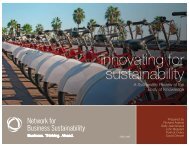Case Study - Network for Business Sustainability
Case Study - Network for Business Sustainability
Case Study - Network for Business Sustainability
Create successful ePaper yourself
Turn your PDF publications into a flip-book with our unique Google optimized e-Paper software.
Engaging the Community: A Knowledge Project<br />
9. DO NOT swim with or feed whales.<br />
10. A vessel's speed shall never exceed 30 knots when it is within ½ mile (880 yards) of any shoreline or known<br />
wildlife viewing areas (Hein Bank, Middle Bank, Constance Bank, etc) at any time during a tour.<br />
11. Report any observations of disturbance or harassment to the WWOANW executive in charge (V.P. US or V.P.<br />
Canada). Please use courtesy reminder <strong>for</strong>m.<br />
Operations vessels around Transient Killer Whales or Baleen Whales<br />
1. All Best Practices Guidelines as they relate to resident killer whales are applicable and must be followed with<br />
the following modifications: Allow 220 yards between vessel and Transient Orca when in the process of a kill.<br />
Porpoises and dolphins:<br />
1. OBSERVE all guidelines <strong>for</strong> watching whales.<br />
2. DO NOT drive through or circle groups of porpoises or dolphins <strong>for</strong> the purpose of bow-riding. Should dolphins<br />
or porpoises choose to ride the bow wave of your vessel, HOLD COURSE AND SPEED or REDUCE SPEED gradually<br />
and avoid sudden course changes.<br />
Seals, sea lions and birds on land:<br />
1. AVOID approaching closer than 100 metres/ yards to any marine mammals or birds.<br />
2. SLOW DOWN and reduce your wake/wash and noise levels. Vessels should slowly pass by without stopping in<br />
order to remain predictable.<br />
3. PAY ATTENTION and slowly back away at the first sign of disturbance or agitation.<br />
4. BE CAUTIOUS AND QUIET when around haul-outs and bird colonies, especially during breeding, nesting and<br />
pupping seasons (generally May to September). In<strong>for</strong>m passengers to avoid loud noises, pointing, and sudden<br />
movements.<br />
5. DO NOT swim with or feed any marine mammals or birds. Rafts of birds on the water should be given as wide<br />
a berth as is practical at cruising speed. Cormorants and Peregrine Falcons are particularly sensitive to<br />
disturbances when nesting. Extra caution should be exercised during nesting periods. Vessels should approach<br />
very slowly, with no wake, no P.A. system, cautioning guests to refrain from making loud noises, and remain at<br />
least 100 yards from rookeries.<br />
Viewing wildlife within Marine Protected Areas, Wildlife Refuges, Ecological Reserves and Parks:<br />
1. CHECK your nautical charts <strong>for</strong> the location of various protected areas.<br />
2. ABIDE by posted restrictions or contact a local authority <strong>for</strong> further in<strong>for</strong>mation.<br />
16
















